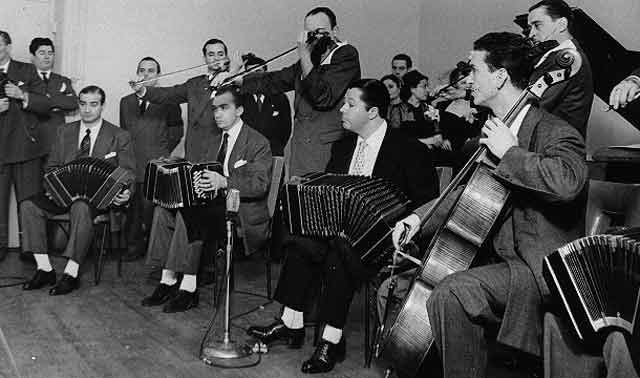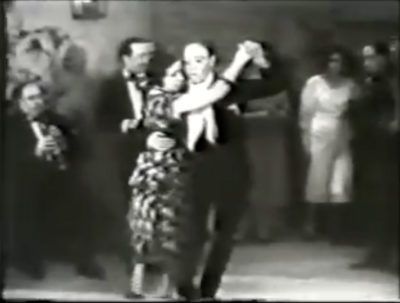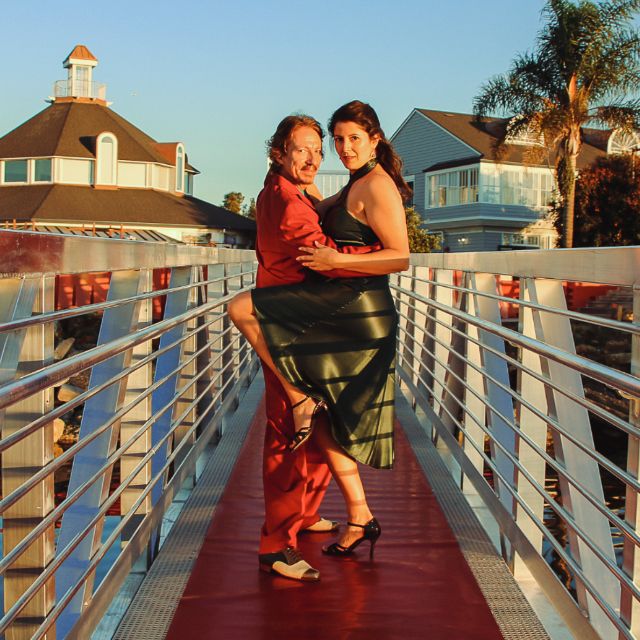Why do I dance Argentine Tango?

I dance Tango because it provides me a sublime experience of joy and wisdom.
However, this experiential value of Tango cannot be achieved if we know beforehand what we have to do at particular conjunctions during the dance.
Only if we train to be relaxed and comfortable with our bodies, in control by letting it go, without anxieties for what may come, breathing, suspending judgments, open to what is becoming, accepting what has happened, and being joyfully aware, we can dance.
Performers who dance a choreography bow to an audience demanding entertainment, and the recognition of their supposed knowledge and expertise.
Dancing is a wonderful way to explore, recreate, and improve ourselves. However, we face the risk of reproducing our deficiencies in our dance.
I know many great dancers. Some have partners with whom they go to milongas, classes, etc. Often their partners are their spouses, or close, intimate friends. Others go out alone and have no problem dancing for as long and with as many partners as they wish. They are good dancers, with more or less experience and expertise. They all share in common that they are pleasant to be close to. Their company is enjoyable —even more people than they wish, want to dance with them. As time goes on, their dance improves, their humanity is further refined, and they end up sharing their time and dancing with people of their choice. Tango is a celebration, and milongas are parties, not a job. There are no obligations in Tango. No obligation to dance with anyone.
If I do not want to dance with anyone at a milonga, I don’t dance. I enjoy going to milongas, and that is already what satisfies me. If I like to dance with someone and that someone wants to dance with me, and we end up dancing, and our dancing turns out to be a wonderful shared time together… that’s amazing!
Are we expecting someone to satisfy our fantasies and spare us from our insecurities before we get on with living our lives? –a thought that I used to have a long time ago but that I was too modest to confess.
Often we are in a delusion of being naturally in control of ourselves. We only achieve this control through regular and disciplined exercise. We often confuse control with rigidity, removing ourselves by avoiding our bodies as much as possible.
Often (very often), the corrections you need to apply to your dancing are corrections needed for your life.
Regarding competitions: Who is going to judge me? God? 🤣
First, let me know who the judges are. I know they will be human (until Artificial Intelligence can replace them). I would only allow myself to be rated by a jury of proven excellence regarding their humanity, counting great dancers as, for my sensitivity, the finest human examples.
As dancers, we suspend judgment, as the skeptic philosophers of Ancient Greece recommended. Our bodies are shaped by the society that raised us. Dancers free themselves from the prejudices engraved in them by the environment in which they were cultivated, by exploring alternatives beyond these prejudices, with great patience and unforgiving self-critique.
We need to become good dancers on our own, learn, work with an experienced teacher and dancer, practice, challenge ourselves to go out, get experience, expose ourselves to milongas, find out how we respond, review our experiences, reflect, apply what we learned into the process of developing and creating our dance –ourselves– as a work of art.
We are always beginners in Tango. The best thing that could happen to you is never losing this feeling. Still, we need to keep improving.
It is not important to dance more, but to dance better.
If we were to dance and live in a fulfilling manner, others would enjoy our company.
We also need to be interested in the people around us. If they do not interest us, we may have become insensitive or surrounded by uninteresting people.
Each person is a whole new world to discover through whom we will find out more about ourselves and participate in that person’s self-discovery. If we do not get this experience with people with whom we dance, what is the difference from the interactions with people we pay for tickets at the entrance of a museum, for instance?
Sometimes we may fantasize about “communion” with a person we dance with, but if we do not go beyond these raw sensations, our dance will not mature, and we do not get the best of what Tango could provide us: a way to enhance our humanity.
Of course, everyone knows their aspirations and limits. We always receive in accordance with what we give.
We can claim to be “seriously” into Tango only when we make it a joyful experience for ourselves and the ones around us.
Tango is not easy in any way, but we can decide how many challenges to take from it and how far to advance into a deeper understanding of the art, of ourselves, and others. We can find excuses for our shortcomings. However, we need to understand that we cannot demand what we cannot achieve if we want to be good dancers; these are admirable human beings.
Another important element on our path to dance Tango is disconnecting it from associations with ballroom dances. There are not but very superficial connections between each other. I believe that you cannot dance ballroom and Tango. You need to give up one of them.
Where to find Tango instruction? There is no better way than going to milongas and observing. I found my teachers there. I saw them dancing and admired them without anyone telling me who they were. I approached them, presenting my delight at witnessing their dance and their superb humanity, and asked them to teach me. No institution nor reputation can replace the inherent experience of enjoying someone’s dancing. We do not learn Tango from institutions, from transcendent abstractions and superstructures; we learn Tango from individuals, fleshy real human beings, the most real that I have ever met.
Tango is a way of life, just as dancing is a way to be a human being. The supreme one for me. If an extraterrestrial civilization contacts us, I wish to be represented by a milonguero/a.
Tango music tells us much about how to dance. It is music that cannot be listened to like a concert. It is meant to be danced as Tango because it arises from the human body, of our particular world, in our time. I am talking about the music that the most knowledgeable and experienced DJs play at milongas, the one that is often identified as the music of the “Golden Era.” We can only claim to know Tango music well when we know its characteristics and particularities, and we can talk about it, giving specific references and examples. Having only cloudy and unspecific “feelings” does not mean knowing the music. That clearly shows in the dance.
Tango is human. I think it is meant to be the culture of humanity.
Spoken and written languages are limited. They will never be enough for our expression. Where our words end, our bodies begin. Then, we dance.
It is always our choice. We are free to take it or leave it.
To dance Tango well has no connection with being a professional dancer. You can be an excellent professional and not dance Tango at all. An excellent Tango dancer is an excellent human being and excellent in every sense.
We build ourselves up from habits. If these habits become mechanical and we end up being unaware of them, we become something akin to robots. We need to review and reconsider our habits constantly to be good dancers.
I do not find the San Francisco Bay Area Tango community cliquish at all. I find that in the milongas of any community globally, people will dance with different approaches and goals. Some people like to go and dance only with their friends, without any interest in meeting new people. Others want to dance with partners that they find could match their dance explorations. Some go to find an intimate relationship. Some to socialize. There are many ways to connect to Tango. All of them are valid as long as they respect the others. You may disagree with other ways to take Tango and the milongas, but you cannot deny to others their own searches. These approaches evolve, change, and mix in different proportions in each individual. People tend to interact with other people with the same, similar, or complementing interests regarding Tango.
You may find it challenging to meet people that connect to your interests and approaches regarding Tango. Your approach and interests regarding Tango may be very particular to you, and very few people share it. Nothing wrong with it. Be patient. The main mistake of new people (meaning people less than ten years into Tango) is to feel entitled to Tango, partners, dances, or anything. In Tango, there is nothing more than your dancing, your involvement in it, and your progress as a dancer in milongas, as a milonguero/a. Often people do not really know why we do Tango. Sometimes they try to give to themselves and others reasons they put in vague words. Tango is so multilayered. In my opinion, the best explanation of why to dance Tango a particular person could give to me is their dance.
We shouldn’t feel entitled to dance with anyone. Dancing with anyone is only worth it if both have a clear desire to dance with each other. In Tango, for the milongueros, meaning regulars at regular milongas, the intention is to regularly dance with that partner of their mutual choice at every milonga they encounter each other.
I always prefer regular milongas to festivals.
If we do not dance tonight, there will be infinite nights to come with the open possibility of dancing together.
The San Francisco Bay Area Tango community is at the worldwide top regarding its quality, and people are lovely, friendly, warm, and kind.
Each one learns better with a particular teacher than with others. Tango teachers waste their time trying to teach everyone and competing for students. A student who is meant to learn with a teacher, in particular, probably won’t find it productive to learn with a different teacher. However, they can learn from various teachers too. A good student can learn from not-so-good teachers. A not-so-good student gets little help from even the best teacher.
Continue learning Argentine Tango:
Latest Spotify playlist:







